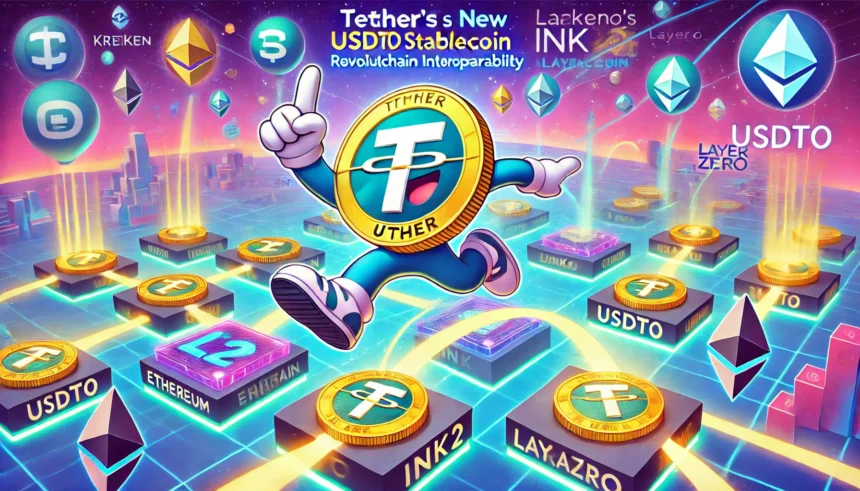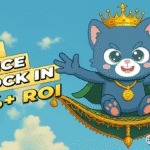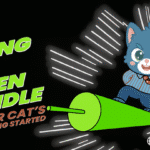Tether has announced the launch of USDT0—a new iteration designed to simplify and accelerate transfers across various blockchain ecosystems. With over 140 billion USDT already circulating, the stablecoin issuer hopes USDT0 will reduce barriers and boost blockchain interoperability.
A Refined Approach to Interoperability
USDT0 is intended to build on Tether’s reputation for fast and reliable transfers by leveraging new technologies to further its cross-chain capabilities. The goal is to let users freely move assets between networks without the typical delays or high fees often associated with multi-chain transactions.
In a statement unveiling the move, the company emphasized that USDT0’s primary mission is to give cryptocurrency traders, institutions, and everyday users an easier way to navigate different blockchain environments. It is also crafted to uphold Tether’s core principle: preserving a stable one-to-one equivalence with the USDT version backed by Ethereum.
LayerZero Integration for Omnichain Transfers
A key part of USDT0’s architecture is its use of the LayerZero omnichannel fungible token (OFT) standard, known for enabling secure, cost-efficient asset transfers across multiple chains. According to the firm, this setup boosts transaction speeds while keeping fees affordable and security protocols intact.

Tether CEO Paolo Ardoino expressed optimism about the project’s potential impact, noting that USDT0 aligns with the company’s overarching vision of “elevating user experience and addressing the growing need for effortless asset transfers.” By incorporating LayerZero’s framework, it hopes to facilitate a new era of cross-network harmony that alleviates the cumbersome process of transferring tokens between distinct protocols.
First Deployment on Kraken’s Ink L2
For its initial rollout, Tether has chosen Kraken’s layer-two protocol, Ink, as the starting point for USDT0. This move is set to simplify how institutional investors access liquidity within Kraken’s ecosystem. Andrew Koller, founder of Ink, welcomed USDT0’s arrival, stating,
“USDT0 choosing Ink as its first chain is the beginning of a new standard for how stablecoin liquidity should flow across all chains in the future.” By launching on Ink, this stablecoin issuer aims to streamline asset management workflows and pave the way for direct USDT0 deposits and withdrawals. The company’s focus is on making sure transactions remain swift, reliable, and tied to Tether’s 1:1 exchange rate with its Ethereum-based counterpart.
Tether’s Collaborations with Berachain and MegaETH
Beyond Ink, Tether has confirmed partnerships with Berachain and MegaETH to further extend USDT0’s reach. Berachain operates as a layer-one blockchain that employs a proof-of-liquidity (PoL) consensus model, rewarding participants who bolster network activity. MegaETH, by contrast, emphasizes real-time processing, reportedly achieving transaction speeds of up to 100,000 per second.

These collaborations reflect Tether’s ambition to diversify USDT0’s applications, particularly in decentralized finance (DeFi) and payment ecosystems. By engaging different layers and protocols, the company hopes to capture a broad segment of users seeking stable, cross-chain liquidity solutions. Looking ahead, the company also plans to embed USDT0 within Kraken’s broader platform, enabling convenient deposits and withdrawals that cater to retail and institutional clients.
Industry Leaders Weigh In
LayerZero CEO Bryan Pellegrino applauded Tether’s initiative, calling USDT0 “an essential innovation that bolsters the stablecoin’s expanding infrastructure.” He suggested that a broader adaptation of the OFT standard could encourage similar projects to follow suit, propelling blockchain interoperability to new heights.
Many in the crypto community see USDT0 as another step toward reducing fragmentation in the digital asset space. As decentralized applications multiply and more users enter the market, seamless transferability between networks becomes increasingly critical.
Conclusion:
For those aiming to incorporate USDT0 into their applications, Tether encourages collaboration to drive adoption and spark innovative use cases. While the road to complete blockchain interoperability is still evolving, USDT0 signifies a notable push toward a future where transferring stablecoins between disparate ecosystems is seamless, affordable, and secure.
As momentum builds, Tether’s foray into multi-chain compatibility could redefine how stablecoin liquidity flows across networks, setting the stage for a new chapter in decentralized finance.
Stay tuned to The BIT Journal and watch Crypto’s updates. Follow us on Twitter and LinkedIn, and join our Telegram channel to be instantly informed about breaking news!
Frequently Asked Questions (FAQs)
1. What is USDT0, and how does it keep a 1:1 peg with Ethereum-based USDT?
It’s Tether’s new multi-chain stablecoin, maintaining the same 1:1 value as Ethereum-based USDT while expanding cross-chain capabilities.
2. How does USDT0 simplify cross-chain transactions?
It reduces fees and delays, making asset transfers between different networks faster and more efficient.
3. What role does LayerZero’s OFT standard play in enabling secure cross-chain transfers?
LayerZero’s OFT framework underpins USDT0, providing quick, secure transactions across multiple blockchains.
4. Why did Tether choose Kraken’s Ink L2 as USDT0’s first platform?
Ink L2 offers a fast, secure environment that streamlines liquidity and demonstrates USDT0’s reliable multi-chain transfers.
5. How do Berachain and MegaETH partnerships expand USDT0’s reach?
They extend USDT0 into different ecosystems—DeFi on Berachain and high-speed transactions on MegaETH—tapping broader user bases.






























